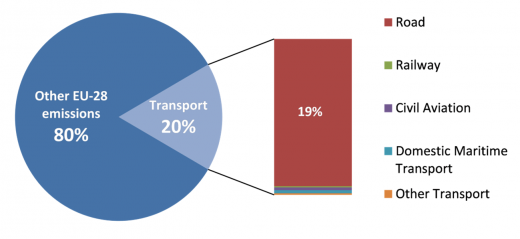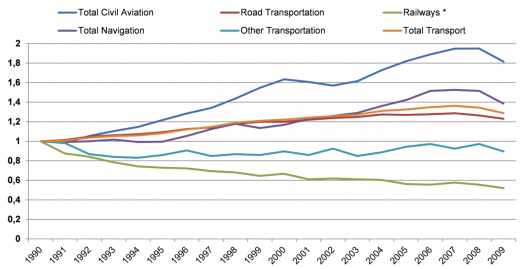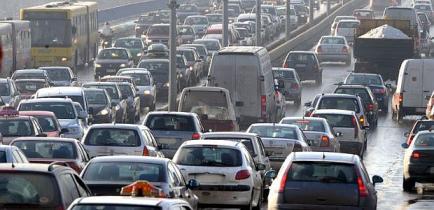Issues:
Sectors:
Keywords:
1. Transport accounts for 21% of all CO2-emissions
The transportation sector includes the movement of people and goods by different means, e.g. cars, trucks, trains, ships, airplanes, and other vehicles1.
The importance of transport sector, in terms of environmental impact, can be further understood by relative numerical data at both global and EU level. The majority of GHG emissions from transportation consist of CO2 emissions resulting from the combustion of petroleum-based products, like gasoline, in internal combustion engines. Globally, the transportation sector accounts for 21% of all anthropogenic CO2 emissions, 19% of volatile organic compounds, 18% of carbon monoxide, 14% of black carbon and 10% or less of the remaining climate-forcing agents identified by the UNFCCC (United Nations Framework Convention on Climate Change)2.
2. GHG emissions from transport are increasing
In the EU-28 in 2011, transport is responsible for around 20% of greenhouse gas (GHG) emissions rendering it the second largest GHG emitting sector after the energy industry. In addition, despite the fact that emissions from other sectors (energy industry, manufacturing etc.) present a general decreasing trend, those from transport have increased by 19% from 1990 to 20113. Emissions from the transport sector showed a continuous growth between 1990 and 2007; followed by a slight dip (-6 %) between 2007 and 20114. This downward trend is, however, considered to be mainly due to the economic recession5.
Over the 1990-2011 period, emissions from road transport and civil aviation grew by 21% and 17% respectively; while emissions from domestic maritime transport presented a 1% growth. In contrast, emissions from railway transportation fell by 46%. A breakdown by sector shows that road transport has dominated emissions from this sector throughout this period (94% in 2011)4.

Figure 1: EU-28 GHG emissions (tn of CO2 equivalent) by mode of transport in 2011. Emissions from international shipping (generated from fuel sold inside the EU-28, but for international shipping)6 are not included.
3. CO2-emissions differ by mode of transport
The amount of CO2 emitted per passenger and kilometre for different modes of transport is highly dependent on the type of vehicle, as well as on the load factor. Typical CO2 emissions of air transport are in the range of 30 to 110 g per passenger/km, which are comparable to passengers travelling by car or light truck. CO2 emissions per passenger/km from bus or coach transport are significantly lower; usually less than 20 g per passenger/km. As concerns rail travel, CO2 emissions depend on several factors, such as the source of primary energy and the load factor, while emissions vary from numbers lower than 5 g to a maximum of 50 g per passenger/km.

Figure 2: Visualization of the GHG emission trends of various transport modes, between 1990 and 2009. (Excluding international bunkers (international traffic departing from the EU), Including International Bunkers but excluding (LULUCF)) (*) Excluding indirect emissions from electricity consumption
4. EU is a key player in reducing global GHG emissions from transport
The EU has been acting in many aspects as a key player in the global efforts to reduce GHG emissions deriving from the transport sector. Significant pieces of legislation (Renewable Energy Directive (RED) (2009/28/EC), Directive on Fuel Quality Standards (FQD) (2009/30/EC), and Regulation 253/2014 of the European Parliament) have been established, targeting mainly road, air and maritime transport and aiming to a drastic reduction of these emissions.
5. Increasing the use of biofuels aims at a 10% share of renewable energy in EU transport
The Renewable Energy Directive (RED) (2009/28/EC), implemented by Member States by December 2010, establishes ambitious targets for all Member States, in order for the EU to reach a 20% share of energy from renewable sources, by 2020, and a 10% share of renewable energy specifically in the transport sector. Regarding the increase of biofuels use in the EU, the RED aims to ensure the sole use of sustainable biofuels, which generate a net GHG emission reduction without negative impacts on biodiversity and land use.
The amended Directive on Fuel Quality Standards (FQD) (2009/30/EC), part of the broader 2008 Climate and Energy Package, introduced for the first time a reduction target for GHG emissions from fuels. By 2020, fuel suppliers have to mitigate climate harmful emissions by 6% over the entire life cycle of their products. This can be reached in particular by blending biofuels into petrol and diesel as well as by improving production technology in refineries. Member States may require an additional 4% reduction from fuel companies, achieved through the supply of energy for electric vehicles or other clean technologies, or through carbon credits from third countries (such as through the Clean Development Mechanism - CDM).
Concerning long-term goals, according to the European Commission’s White Paper on Transport issued in 2011, a 50% reduction in the use of ‘conventionally-fuelled’ cars in urban transport is targeted by 2030. An intention of having them phased out of cities by 2050 is pursued, while CO2-free city logistics in major urban centres are to be achieved by 20307.
6. EU car manufacturers are obliged to reduce emissions of their fleets
In 1998, the Association of European Automobile Manufacturers, which represented over the 80% of annual registrations in the EU, committed voluntarily to achieve an emissions objective of 140 grams of CO2 per km by 2008, by introducing technological developments and market changes linked to these developments.
However, in 2008, the Commission found that, the overall CO2 emission reduction target for 2012, set by the EU, would not be met within the deadline unless additional measures are taken8.
Consequently, mandatory reductions were introduced by regulation in the following year, setting emission performance standards for new passenger cars. In 2014, these were extended to 2021 and increased. According to Regulation 333 of 2014, amending Regulation 443 of 2009, car manufacturers are now obliged to ensure that their new car fleet will gradually emit less than 95 grams of CO2 per km by 2021. In terms of fuel consumption, the 2021 target equates approximately to 4.1 lt/100 km of petrol or 3.6 lt/100 km of diesel.
For vans, according to Regulation 253 of 2014, amending Regulation 510 of 2011, the mandatory target is 147 grams of CO2 per km by 2020, while fuel consumption should not exceed 6.3 lt/100 km of petrol or 5.5 lt/100 km of diesel in 2020.9
After having regulated emissions from cars and vans, the European Commission established, in May 2014, a strategy in order to curb emissions from trucks, buses and coaches. The new strategy focuses on short-term action to certify report and monitor emissions from Heavy Duty Vehicles (HDVs) with the support of technology. This is meant to lead to proposals for legislation in 2015, including the setting of mandatory limits on average CO2 emissions from newly registered HDVs being the most apparent option. Studies conducted while preparing the strategy suggest that state-of-the-art technologies can achieve cost-effective reductions in CO2 emissions from new HDVs of at least 30%10.
Furthermore, in order to control emissions from fluorinated greenhouse gases (F-gases), including hydrofluorocarbons (HFCs), the EU has adopted two legislative acts: the "MAC Directive" on air conditioning systems used in small motor vehicles, and the "F-gas Regulation" which covers all other key applications in which F-gases are used. Regarding the sector of transport, the F-Gas Regulation prohibits the use of F-gases with a global warming potential of more than 150 times greater than CO2 in new types of cars and vans introduced from 2011, and in all new cars and vans produced from 2017.
In addition, rolling resistance limits and tyre labelling requirements have been introduced and installation of tyre pressure monitors made mandatory on new vehicles (Regulation 661/2009), as tyres have been identified as potential sources for improvements in vehicle fuel economy and, thus, reductions in CO2 emissions11.
7. Market mechanisms enhance emission reduction from transport
With the introduction of the Directive on the Promotion of Clean and Energy Efficient Road Transport Vehicles (2009/33/EC), the European Commission (EC) aims at a broad market introduction of environmental-friendly vehicles. Public procurement can be a powerful market mover for the introduction of innovative technologies. The Directive extends to all purchases of road transport vehicles, as covered by the Public Procurement Directives (2004/17/EC, 2004/18/EC). According to this, energy and environmental impacts associated with the operation of vehicles during their whole lifetime should be considered in the purchase decision making process. Minimum factors to be included in these impacts are energy consumption, CO2 emissions, as well as pollutant emissions13.
These requirements will be met via two options: technical specifications for energy and environmental performance setting or energy and environmental impacts inclusion as award criteria in the purchasing procedure. The expression of impacts in currency terms to facilitate inclusion in the purchasing decision, will be regulated by common rules, as defined in the Directive on the Promotion of Clean and Energy Efficient Road Transport Vehicles (2009/33/EC), for calculating the lifetime costs linked to the operation of vehicles14.
This effort to internalise external costs into new vehicle procurements is envisaged to improve the contribution of the transport sector to the environment, climate and energy policies of the EC.
8. Aviation is one of the fastetst-growing sources of GHG emissions
By 2020, global international aviation emissions are projected to be around 70% higher than in 2005 even if fuel efficiency improves by 2% per year, and by 2050 they could grow by a rate of 300%-700% (ICAO)13. In order to offset these growing emissions, the EU includes the aviation sector in the EU ETS. Consequently, since early 2012, emissions from all flights from, to and within the EU-28 Member States plus Iceland, Liechtenstein and Norway, are included in the EU-ETS.
Following controversy of its plans to include also emissions from airplanes going to and from the EU to non-European destinations, EU-ETS requirements for flights in 2012 for those flights to and from non-European countries were suspended, in order to facilitate negotiations on a worldwide level under the auspices of ICAO. For the period afterwards (2013-2016), emissions from flights within the EEA (European Economic Area) have been included into the EU-ETS.
9. EU wants to cut emissions from shipping by at least 40% until 2050
Shipping is also a large and growing source of GHG emissions, as the combination of domestic and international maritime transport accounts for 4% of the total EU emissions. Without action, these emissions are expected to more than double by 205014. This scenario is definitely incompatible with the internationally agreed goal of keeping the increase of the mean global temperature below 2°C, which requires emission reductions in all sectors. The Commission's 2011 White Paper on Transport suggests that the EU's CO2 emissions from maritime transport should be cut by at least 40% in 2050, compared to 2005 levels, setting an even more ambitious goal of 50%, if feasible.
Although international shipping is not covered by the EU’s current emissions reduction target, a new strategy was communicated by the EC to the Parliament in June 2013, (COM (2013) 479 final), for integrating maritime emissions into the EU's policy for domestic GHG emissions reduction. The strategy consists of three consecutive steps:
- CO2 emissions from large ships using EU ports will be monitored, reported and verified;
- Specific reduction targets concerning GHG emissions from activity of the maritime transport sector will be established;
- Further measures for the medium to long-term will be implemented, including Market Based Measures (MBMs).15
Although, existing objectives set are ambitious, studies mention that GHG emissions of the maritime sector are directly linked to the fuel consumption which operational cost can be up to 33% to 63% of the total operational costs of ship. Despite the fact that fuel cost is constantly being increased, energy saving measures have not been implemented on a wide level. In addition, latest studies conclude that actions of CO2 reduction are not being implemented as they are subject to several market barriers (access to finance, lack of adequate information, and split of incentives). An additional critical parameter is the experiencing growth of the EU shipping sector that results in a substantial enhancement of its CO2 emissions. It is considered that even if price of fuel constitutes a critical influential parameter, market barriers have to be removed in order to achieve the reduction of the respective GHG emissions16.
10. Future trends
As in the past, in the following years, the transport sector will not be isolated from other policy areas in terms of EU climate policy. The 2020 strategy adopted by the EU sets the framework for combining the augmentation in energy efficiency in all crucial sectors of activity, such as transport, buildings, industry etc. It can be understood that strong links have been developed among different sectors, as the main emitting sectors share similar targets. Such targets refer to the acceleration of the renovation rate, the introduction of energy criteria into all public procurement of works, services or products, the development of financial programmes targeting sustainability projects and the reduction of oil dependence.
Legislation concerning cars and vans (Regulation No. 333/2014 for cars, No. 253/2014 for vans) asks the Commission to set post-2020 targets by the end of 2015, in order to ensure that CO2 emissions from light-duty vehicles will continue to follow a downward trend. Such a commitment will also offer the automotive industry the certainty it needs to implement long-term investments and develop innovative technologies. A thorough assessment of economic, social and environmental impacts will form the basis for any proposal of future targets20.
In the long term, a wide deployment of clean and energy efficient vehicles is expected to be triggered by the Directive on the Promotion of Clean and Energy Efficient Road Transport Vehicles. An increase in sales is envisaged to lead to subsequent cost reduction through economies of scale and progressively expand to the improvement of energy and environmental performance of the vehicle fleet in total13.
In addition, the original F-Gas Regulation (No 842/2006), adopted in 2006, is being replaced by a new regulation (517/2014), adopted in 2014, which applies from January 1, 2015. This strengthens existing measures and introduces a number of far-reaching changes, therefore appearing to be the main driver of the move towards more climate-friendly technologies in the transport sector. It is projected that the new F-gas Regulation will be able to cut the EU’s F-gas emissions by two-thirds by 2030 compared to 2014 levels. Though ambitious, this reduction is achievable at relatively low cost because climate friendly alternatives are readily available for many of the products and equipment in which F-gases are commonly used today (in the transport sector, this applies to air conditioning in particular).
The EU 2030 framework adopted by Heads of State and Government in October 2014 does not contain any specific transport target for renewable energy or GHG emissions reduction. However, transport emissions are included in the target for those sectors not included under the Emissions Trading System (ETS). Non-ETS emissions are set to be cut down by 10%, from 2005 levels, by 202017. This emission reduction objective along with the 21% cut in emissions included in the EU ETS will lead to an overall 20% reduction of GHG emissions below 1990 levels by 2020. Clearly, this implies significant reductions in the transport sector from current levels.
As the EC indicated in January 2014, first generation biofuels only contribute to transport decarbonisation to a limited extent. Alternative renewable fuels accompanied by a mix of focused policy measures building on the Transport White Paper, are concerned as crucial to face challenges of the sector in the long-term. According to the EC23, policy development should be orientated to a holistic approach, focused on efficiency improvements of the transport system, electric vehicles, second and third generation biofuels and other alternative, sustainable fuels24.
Based on the European Roadmap on Infrastructure for Green Vehicles (European Road Transport Research Advisory Council ERTRAC), the actions from the sides of both road transport stakeholders and legislation have to be coordinated in order to prevent the secure development of environmentally friendly mobility. Several important benefits and challenges that arise from the development of Infrastructure for Green vehicles, as coordinated measures and integration at an EU level have to be achieved, followed, although, by high investment cost and different cycle times of the different industries (including roads, cars, ICT) that have to be undertaken.
The main policy actions and relevant research include transport efficiency, energy efficiency and alternative fuels and propulsion systems. Transport efficiency incorporates measures regarding the improvement of transport infrastructures and services. Energy efficiency focuses on the technological advances that lead to an increase of the energy efficiency of vehicles. At last, the third issue involves the substitution of conventional sources of energy with more clean fuels20.
